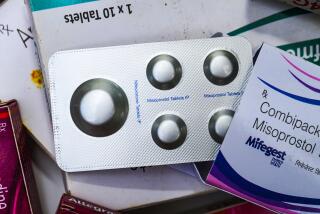Avastin debate: Science vs. emotion
- Share via
The debate over whether federal regulators should allow Avastin to be marketed as a breast cancer treatment has been characterized as a battle between science and emotion. On one side stands a Food and Drug Administration appeals panel that urged the agency last week to rescind its approval of the drug’s use against advanced breast cancer, citing clinical studies that showed no improvement in a patient’s chances of survival or quality of life. On the other is a group of women who told the panel at a hearing that they’d be dead if not for Avastin.
It’s a dramatic showdown, and the stakes are enormous: Avastin is widely used to fight several different cancers, and up to $1 billion a year is spent on the costly drug just by patients with metastatic breast tumors. Contrary to what Avastin’s backers claim, however, there are no villainous penny-pinching bureaucrats or heartless number crunchers in this story. The conflict springs purely from the limits of what we know about cancer and how to defeat it.
Studies on thousands of patients show that the combination of Avastin and other chemotherapy drugs can inhibit the growth of tumors, but only for a few weeks. And in the long run, the studies show, patients on Avastin live no longer than the ones who don’t take it. In light of the serious side effects and the handful of deaths attributed to the drug, the FDA’s advisory group on oncology drugs recommended last year that the agency withdraw the provisional approval it had granted in 2008, and an appeals panel unanimously backed that recommendation last Wednesday.
The data cited by the panel are hard to reconcile with the survivors’ testimony. Panel members argued that based on the results from thousands of users in clinical trials, the survivors aren’t being sustained by Avastin — their cancers are being held in check by the other chemotherapy they’re receiving. The survivors disagree, as do some experts who’ve looked at the same clinical data and concluded that Avastin does impede tumor growth, at least temporarily, for a small portion of the gravely ill women who take it. The problem is that, so far, no one has figured out how to tell who can and who cannot be helped by it.
With individuals, employers and governments struggling with ever-rising healthcare costs, it’s tempting to call for the FDA to scorn expensive treatments such as Avastin that have trouble proving their benefit. But the agency’s credibility depends on it making decisions purely on the medical evidence. And unfortunately, the evidence about Avastin and breast cancer is mixed — so much so that 21 top cancer hospitals have reaffirmed their support for the drug, and European regulators recently approved its use in a new combination of chemotherapies.
The FDA is still accepting comments from the public, and FDA Commissioner Margaret A. Hamburg isn’t expected to make a final decision for several weeks. Medicare has already declared that it will continue to pay for the use of Avastin by breast cancer patients regardless of what the FDA does, as have some — but not all — private insurers. Avastin poses a conundrum that’s all too common in medicine: Why does the drug seem to do so much for a few patients but so little for many others? It’s a mystery worth trying to solve.






